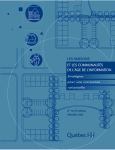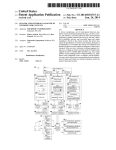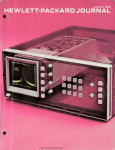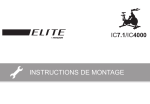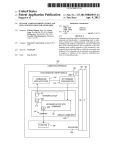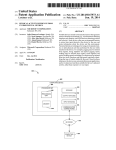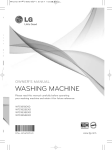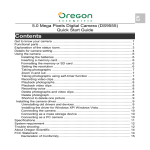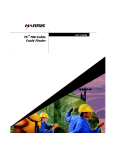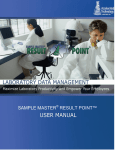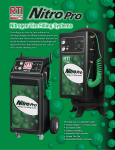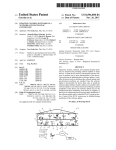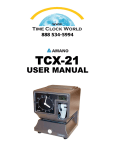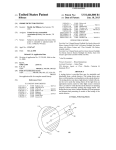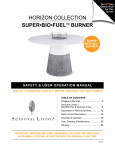Download Opinion search engine
Transcript
US 20110078157A1 (19) United States (12) Patent Application Publication (10) Pub. No.: US 2011/0078157 A1 Sun et al. (54) (43) Pub. Date: OPINION SEARCH ENGINE Publication Classi?cation (51) (75) Inventors: Mar. 31, 2011 . Int. Cl. G06F 17/30 Jlan-Tao Sun, Beijing (CN); (2006.01) G06F 7/00 (200601) iiaolghgan ?TCLI\IB)BijGiHg (CV15); Peng (52) us. Cl. ...................................................... .. 707/749 Beijing (CN); Ke Tang, Beijing (CN); Zheng Chen, Beijing (CN) (57) ABSTRACT A computer-readable storage medium having stored thereon u, e1j1ng ; ang ang, computer-executable instructions Which, When executed by a computer, cause the computer to implement an opinion (73) Assignee; Microsoft Corporation’ Redmond’ search engine. The instructions to implement an opinion WA (Us) search engine cause the computer to collect opinion data about one or more objects from the lntemet, extract metadata about the opinion data from the opinion data, remove dupli cate metadata from the metadata to generate a resulting meta (21) Appl' N05 12/568,702 data, categorize the resulting metadata for similar objects according to one or more taxonomies from one or more Web sites on the lntemet and rank the similar objects based on the (22) Filed: Sep. 29, 2009 categorized metadata. 2 0 COLLECT OPINION DATA FROM INTERNET I EXTRACT METADATA FROM OPINION DATA I AGGREGATE METADATA I CATEGORIZE METADATA I RANK OPINION DATA K 220 K 230 T 240 K 2 K Patent Application Publication Mar. 31, 2011 Sheet 1 0f 4 US 2011/0078157 Al on Patent Application Publication Mar. 31, 2011 Sheet 2 0f 4 US 2011/0078157 A1 20 COLLECT OPINION DATA FROM INTERNET I EXTRACT METADATA FROM OPINION DATA I AGGREGATE METADATA I CATEGORIZE METADATA I RANK OPINION DATA FIG. 2 K2 0 220 K 230 K 240 K 250 K Patent Application Publication Mar. 31, 2011 Sheet 3 0f 4 0 FIG. 3 US 2011/0078157 A1 Patent Application Publication Mar. 31, 2011 Sheet 4 0f 4 US 2011/0078157 A1 MONTH1 K [MONTH 2 V TOTAL POS|T|VE NEGATIVE TOTAL POSITIVE +34% NEGATIVE -0.1% -1% 0% 1% FIG. 4 2% 3% US 2011/0078157 A1 OPINION SEARCH ENGINE BACKGROUND [0001] Internet users (reviewers) use various Web-based forums such as blogs and revieW Websites to express their Mar. 31, 2011 essential features of the claimed subject matter, nor is it intended to be used to limit the scope of the claimed subject matter. Furthermore, the claimed subject matter is not limited to implementations that solve any or all disadvantages noted in any part of this disclosure. opinion about any topic of interest such books, hotels, con sumer products, political policy and the like. These opinions about various topics of interest may be referred to as opinion data. Opinion data is typically used to help consumers make an informed purchase decision about an item that they may Wish to purchase based on the opinions of other consumers. Opinion data is also used to help companies learn more about hoW their customers rate their products, customer sentiment for their products and customer satisfaction for their products. BRIEF DESCRIPTION OF THE DRAWINGS [0005] FIG. 1 illustrates a schematic diagram of a comput ing system in Which the various techniques described herein may be incorporated and practiced. [0006] FIG. 2 illustrates a How diagram of a method for implementing an opinion search engine in accordance With one or more implementations of various techniques described net, opinion data is voluminous and includes a plethora of herein. [0007] FIG. 3 illustrates a graph of a trend of opinion data for a single product in accordance With one or more imple diverse topics, Which makes it dif?cult for users to locate mentations of various techniques described herein. Since anyone can add an opinion about anything on the Inter relevant opinions related to their topic of interest. [0008] FIG. 4 illustrates graphs of opinion change data for a single product in accordance With one or more implemen SUMMARY [0002] Described herein are implementations of various technologies for implementing an opinion search engine. In tations of various techniques described herein. DETAILED DESCRIPTION one implementation, a computer application may access each Webpage available on the Internet and determine Whether [0009] In general, one or more implementations described herein are directed to implementing an opinion search engine. each Webpage contains opinion data. If the Webpage contains opinion data, the computer application may store the Various techniques for implementing an opinion search Webpage on a ?rst database. The computer application may then extract information pertaining to the opinion data from each Webpage stored on the ?rst database. While extracting the information pertaining to the opinion data, the computer application may determine Whether the information corre sponds to a particular category of information or an informa tion data type. The computer application may then store the information pertaining to the opinion data in a second data base according to the information’s particular category. In this manner, the second database may be structured according to the properties of the information. [0003] The computer application may then remove dupli cative information and group similar information together. In addition to removing duplicative information from the second database and group similar information together, the com puter application may determine a taxonomy for the informa tion in the second database. The taxonomy may refer to a classi?cation scheme such that the information in the second database may be organiZed in a hierarchal structure. In order to determine an appropriate taxonomy for all of the informa tion in the second database, the computer application may examine the taxonomies of each Webpage listed in the second database. In one implementation, the computer application may leverage each Web page’s link paths and site map infor mation to determine the appropriate taxonomy for all of the information in the second database. After determining the appropriate taxonomies, the computer application may orga niZe the information pertaining to the opinion data in the second database according to the appropriate taxonomy. The computer application may then use the organiZed information in the second database to rank products, product categories, opinions, and other opinion-related subject matter on the Internet. [0004] The above referenced summary section is provided to introduce a selection of concepts in a simpli?ed form that are further described beloW in the detailed description sec tion. The summary is not intended to identify key features or engine Will be described in more detail With reference to FIGS. 1-4. [0010] Implementations of various technologies described herein may be operational With numerous general purpose or special purpose computing system environments or con?gu rations. Examples of Well knoWn computing systems, envi ronments, and/or con?gurations that may be suitable for use With the various technologies described herein include, but are not limited to, personal computers, server computers, hand-held or laptop devices, multiprocessor systems, micro processor-based systems, set top boxes, programmable con sumer electronics, netWork PCs, minicomputers, mainframe computers, distributed computing environments that include any of the above systems or devices, and the like. [0011] The various technologies described herein may be implemented in the general context of computer-executable instructions, such as program modules, being executed by a computer. Generally, program modules include routines, pro grams, objects, components, data structures, etc. that per forms particular tasks or implement particular abstract data types. The various technologies described herein may also be implemented in distributed computing environments Where tasks are performed by remote processing devices that are linked through a communications netWork, e. g., by hardWired links, Wireless links, or combinations thereof. In a distributed computing environment, program modules may be located in both local and remote computer storage media including memory storage devices. [0012] FIG. 1 illustrates a schematic diagram of a comput ing system 100 in Which the various technologies described herein may be incorporated and practiced. Although the com puting system 100 may be a conventional desktop or a server computer, as described above, other computer system con ?gurations may be used. [0013] The computing system 100 may include a central processing unit (CPU) 21, a system memory 22 and a system bus 23 that couples various system components including the system memory 22 to the CPU 21. Although only one CPU is US 2011/0078157 A1 Mar. 31, 2011 illustrated in FIG. 1, it should be understood that in some [0016] implementations the computing system 100 may include hard disk 27, magnetic disk 29, optical disk 31, ROM 24 or more than one CPU. The system bus 23 may be any of several types of bus structures, including a memory bus or memory RAM 25, including an operating system 35, one or more controller, a peripheral bus, and a local bus using any of a gram data 38, and a database system 55. The operating system 35 may be any suitable operating system that may control the variety of bus architectures. By Way of example, and not limitation, such architectures include Industry Standard Architecture (ISA) bus, Micro Channel Architecture (MCA) bus, Enhanced ISA (EISA) bus, Video Electronics Standards Association (VESA) local bus, and Peripheral Component Interconnect (PCI) bus also knoWn as MeZZanine bus. The system memory 22 may include a read only memory (ROM) 24 and a random access memory (RAM) 25. A basic input/ output system (BIOS) 26, containing the basic routines that help transfer information betWeen elements Within the com puting system 100, such as during start-up, may be stored in A number of program modules may be stored on the application programs 36, an opinion search engine 60, pro operation of a netWorked personal or server computer, such as Windows@ XP, Mac OS® X, Unix-variants (e. g., Linux® and BSD®), and the like. The opinion search engine 60 Will be described in more detail With reference to FIG. 2 in the paragraphs beloW. [0017] A user may enter commands and information into the computing system 100 through input devices such as a keyboard 40 and pointing device 42. Other input devices may include a microphone, joystick, game pad, satellite dish, scanner, or the like. These and other input devices may be connected to the CPU 21 through a serial port interface 46 the ROM 24. coupled to system bus 23, but may be connected by other [0014] The computing system 100 may further include a hard disk drive 27 for reading from and Writing to a hard disk, a magnetic disk drive 28 for reading from and Writing to a removable magnetic disk 29, and an optical disk drive 30 for reading from and Writing to a removable optical disk 31, such interfaces, such as a parallel port, game port or a universal serial bus (U SB).A monitor 47 or other type of display device may also be connected to system bus 23 via an interface, such as a video adapter 48. In addition to the monitor 47, the the magnetic disk drive 28, and the optical disk drive 30 may computing system 100 may further include other peripheral output devices such as speakers and printers. [0018] Further, the computing system 100 may operate in a be connected to the system bus 23 by a hard disk drive inter face 32, a magnetic disk drive interface 33, and an optical netWorked environment using logical connections to one or more remote computers 49. The logical connections may be drive interface 34, respectively. The drives and their associ ated computer-readable media may provide nonvolatile stor age of computer-readable instructions, data structures, pro gram modules and other data for the computing system 100. any connection that is commonplace in o?ices, enterprise Wide computer netWorks, intranets, and the Internet, such as as a CD ROM or other optical media. The hard disk drive 27, local area netWork (LAN) 51 and a Wide area netWork (WAN) 52. [0015] Although the computing system 100 is described [0019] herein as having a hard disk, a removable magnetic disk 29 computing system 100 may be connected to the local netWork and a removable optical disk 31, it should be appreciated by those skilled in the art that the computing system 100 may also include other types of computer-readable media that may be accessed by a computer. For example, such computer readable media may include computer storage media and communication media. Computer storage media may include volatile and non-volatile, and removable and non-removable media implemented in any method or technology for storage of information, such as computer-readable instructions, data structures, program modules or other data. Computer storage media may further include RAM, ROM, erasable program 51 through a netWork interface or adapter 53. When used in a mable read-only memory (EPROM), electrically erasable programmable read-only memory (EEPROM), ?ash memory or other solid state memory technology, CD-ROM, digital versatile disks (DVD), or other optical storage, magnetic cassettes, magnetic tape, magnetic disk storage or other mag When using a LAN netWorking environment, the WAN netWorking environment, the computing system 100 may include a modem 54, Wireless router or other means for establishing communication over a Wide area netWork 52, such as the Internet. The modem 54, Which may be internal or external, may be connected to the system bus 23 via the serial port interface 46. In a netWorked environment, program mod ules depicted relative to the computing system 100, or por tions thereof, may be stored in a remote memory storage device 50. It Will be appreciated that the netWork connections shoWn are exemplary and other means of establishing a com munications link betWeen the computers may be used. [0020] It should be understood that the various technolo gies described herein may be implemented in connection With hardWare, softWare or a combination of both. Thus, various technologies, or certain aspects or portions thereof, may take the form of program code (i.e., instructions) embodied in netic storage devices, or any other medium Which can be used to store the desired information and Which can be accessed by tangible media, such as ?oppy diskettes, CD-ROMs, hard the computing system 100. Communication media may embody computer readable instructions, data structures, pro drives, or any other machine-readable storage medium Wherein, When the program code is loaded into and executed gram modules or other data in a modulated data signal, such by a machine, such as a computer, the machine becomes an as a carrier Wave or other transport mechanism and may apparatus for practicing the various technologies. In the case of program code execution on programmable computers, the computing device may include a processor, a storage medium include any information delivery media. The term “modu lated data signal” may mean a signal that has one or more of its characteristics set or changed in such a manner as to encode information in the signal. By Way of example, and not limitation, communication media may include Wired media such as a Wired netWork or direct-Wired connection, and Wireless media such as acoustic, RF, infrared and other Wire less media. Combinations of any of the above may also be included Within the scope of computer readable media. readable by the processor (including volatile and non-volatile memory and/or storage elements), at least one input device, and at least one output device. One or more programs that may implement or utiliZe the various technologies described herein may use an application programming interface (API), reusable controls, and the like. Such programs may be imple mented in a high level procedural or object oriented program US 2011/0078157 A1 ming language to communicate With a computer system. However, the pro gram(s) may be implemented in assembly or machine language, if desired. In any case, the language may be a compiled or interpreted language, and combined With Mar. 31, 2011 specify a particular product or product category (e.g., object) that may be of interest to the user. After receiving the speci?ed product or product category, the opinion search engine 60 may access all of Web pages that are available on the Internet hardWare implementations. and determine Whether each Web page contains opinion data [0021] related to the speci?ed product or product category. Upon determining that the Web page includes opinion data related to the speci?ed product or product category, the opinion FIG. 2 illustrates a How diagram of a method for implementing an opinion search engine in accordance With one or more implementations of various techniques described herein. The folloWing description of How diagram 200 is made With reference to computing system 100 of FIG. 1 in accordance With one or more implementations of various techniques described herein. It should be understood that While the operational ?oW diagram 200 indicates a particular order of execution of the operations, in some implementa tions, certain portions of the operations might be executed in a different order. In one implementation, the method for implementing an opinion search engine may be performed by the opinion search engine 60. [0022] At step 210, the opinion search engine 60 may col search engine 60 may store the corresponding Web page and the information on the Web page in the opinion database. In one implementation, step 210 may be executed by an opinion data craWler module that may be part of the opinion search engine 60. Although the opinion data has been described as being related to products or product categories, it should be understood that throughout this document the opinion data may refer to any opinion about any subject matter. [0025] At step 220, the opinion search engine 60 may matter of interest that may be displayed on the Internet. In one extract metadata from each Webpage stored on the opinion database. The metadata may include information pertaining to the opinion data on the Webpage stored on the opinion database. In one implementation, the information pertaining to the opinion data may include a date and time in Which the implementation, the opinion search engine 60 may ?rst opinion Was posted on the Webpage, a name or user identi? access every Website and Web page available on the Internet. cation of the user Who posted the opinion, a product pertain ing to the opinion, a product brand pertaining to the opinion, lect opinion data from the Internet. The opinion data may include revieWs or ratings pertaining to an object or subject The Web pages available on the Internet may include blogs, neWsgroups, forums and other forms of Web-based informa tion that may be accessible by the opinion search engine 60 via the Internet. After accessing each Web page, the opinion search engine 60 may then determine Whether the Web page contains opinion data about an object. Opinion data about the objects may relate to revieWs about consumer products, vaca tion locations or any other subject matter that may be of interest to a user. Upon determining that the Web page the text of the opinion, a sentiment polarity of the opinion or any other subject matter pertaining to the opinion. The opin ion search engine 60 may determine a product’s brand name by using a ?nite state machine. [0026] In order to determine a product’s brand name using a ?nite state machine, the opinion search engine 60 may use a Word breaker to generate or create a sequence of terms contained in a product name as it is listed on a Web page. includes opinion data, the opinion search engine 60 may store Given a ?nite state machine having states and transitions the corresponding Web page and the information on the Web page in an opinion database. The Web pages and the informa tion on the Web pages stored on the opinion database include represented by terms and grammar, and an input term a subset of the Web pages available on the Internet. In one to ?nd a minimal set of modi?cations that may be made to the implementation, the opinion database may be stored on a ?nite state machine such that the input term sequence is server such that the server may be accessible via the Internet. acceptable. In one implementation, the opinion search engine The opinion database may be stored on the database system 60 may run the algorithm iteratively and update the ?nite state machine such that it contains the input term sequence. The 55 as described in FIG. 1. [0023] In one implementation, in order to determine Whether the Web page contains opinion data, the opinion search engine 60 may check hoW many opinion Words are contained in a Web page. If the number of opinion Words exceeds a prede?ned threshold, the opinion search engine 60 may describe the Web page as having opinion data. Opinion Words may include Words that are usually used to express opinions (e.g., “good”, “exciting” and “bad”). In one imple mentation, the opinion Words may be manually provided by both human editors and machine learning algorithms. In prac tical applications, machines may be used to generate opinion sequence (e.g, product) that is not accepted by the ?nite state machine, the opinion search engine 60 may use an algorithm opinion search engine 60 may update the ?nite state machine through induction such that the transition represented by the terms may be changed into transitions represented by gram mar, and neW transitions and neW states may be added to the ?nite state machine if they Were not previously represented on the ?nite state machine. The output of algorithm is a ?nite state machine consisting of multiple state sequences such that each state sequence is a product name. The opinion search engine 60 may then use the updated ?nite state machine to predict if an input term sequence corresponds With a brand name. Words and then human editors may manually check or ?lter them in order to ensure the quality of the opinion Words. [0027] Upon extracting the metadata from the Web pages in the opinion database, the opinion search engine 60 may deter Although Web pages having opinion data have been described as being identi?ed by determining hoW many opinion Words are contained in the Web pages, it should be noted that in other mine Whether the metadata corresponds to a particular data property of a product ontology. The data properties of a prod uct ontology may represent categories or de?nitions for the implementations various algorithms may be used to deter metadata. In one implementation, the opinion search engine mine Whether the opinion data is contained on the Web pages. 60 may receive a list of key Words for each data property or [0024] In another implementation, the opinion search engine 60 may collect only targeted or speci?c opinion data category. The opinion search engine 60 may then use a fuZZy match algorithm to locate the key Words that may be listed in from the Internet as opposed to all of the opinion data avail the metadata and assign the unstructured metadata to a cor able on the Internet. In this implementation, a user may responding data property. The product ontology may provide US 2011/0078157 A1 Mar. 31, 2011 an e?icient mechanism to build an association among opinion revieWs are similar because they pertain to the same product data and their corresponding properties. In one implementa or object. As such, the opinion search engine 60 may combine tion, the product ontology may be based on a universal ontol or aggregate the metadata related to the tWo similar revieWs. ogy model such that the raW data on any data source, such as [0032] At step 240, the opinion search engine 60 may cat egorize or organize the opinion data in the aggregated opinion a Webpage, may be mapped to a corresponding data property. In this manner, the product ontology may provide a scalable architecture such that information from various Web sites and data sources may be more easily integrated by the opinion search engine 60. [0028] In one implementation, the product ontology may be de?ned by summarizing the details of product speci?ca tions published by manufacturer Websites, shopping sites, revieW sites and other related data sources. The ontology may be de?ned in OWL, a standard ontology language published by the World Wide Web Consortium (W3 C). OWL may facili tate a greater machine interpretability of Web content than that supported by Extensible Markup Language @(ML), Resource Description Framework (RDF), RDF Schema (RDFS), DARPA Agent Markup Language (DAML) by pro viding additional vocabulary along With a formal semantics. Depending on the extensibility of OWL, the product ontology de?nition may be extended With additional ontology, prop erty and relationship de?nition. [0029] After identifying the keyWords related to the meta data on each Webpage, the opinion search engine 60 may store the metadata of the opinion data in an opinion metadata database. In one implementation, the opinion metadata data base may be structured in a manner such that the information pertaining to the opinion data may be easily queried. The opinion metadata database may be structured according to the data properties of the product ontology. For example, the metadata database may store information pertaining to the opinion data in a spreadsheet such that each column of the spreadsheet may de?ne a different property of the opinion data. In one implementation, the text information reciting a user’s revieW or opinion of a product may not be stored in a structured format since the text provided by each user may differ greatly and may not be easily queried. [0030] At step 230, the opinion search engine 60 may aggregate the opinion data in the opinion metadata database. As such, the opinion search engine 60 may identify and group all of the opinion data obtained from various Web pages on the Internet pertaining to the same subject matter. In order to aggregate the opinion data, the opinion search engine 60 may determine Whether tWo or more opinion data in the opinion metadata database are duplicative. In one implementation, duplicative opinion data may include instances When a single user Writes the same revieW for a single product on tWo metadata database according to a taxonomy of hierarchal categories. In one implementation, the opinion search engine 60 may determine the taxonomy of hierarchal categories by evaluating the category taxonomies of the Web pages from Which the opinion data in the opinion database may have been obtained. In evaluating the category taxonomies of each Web page, the opinion search engine 60 may leverage each Web page’s link paths and site map information that may be hidden in source sites. By leveraging each Web page’s link paths and site map information, the opinion search engine 60 may reduce and consolidate the taxonomy of hierarchal categories of each Web page and resolve the inconsistencies betWeen the different category taxonomies of different Web pages. In other Words, the opinion search engine 60 may create a neW tax onomy based on the consolidated taxonomy of hierarchal categories from the different Web pages. In one implementa tion, after determining the neW taxonomy, the opinion search engine 60 may modify the opinion metadata database such that it is organized according to the neW taxonomy. This neWly organized opinion metadata database may be referred to as a categorized opinion database. For example, on Website “A,” there may be a “vehicle” category that contains a list of car model manufactures like “BMW”, “Toyota,” etc. as sub categories. On Website “B,” there may be an “automotive” category that contains sub-categories that are similar With those of the “vehicle” category of Website “A.” The opinion search engine 60 may then assume that “vehicle” and “auto motive” most likely correspond With a similar concept, thereby resolving the inconsistencies betWeen different cat egory taxonomies on different Web pages. [0033] At step 250, the opinion search engine 60 may rank or recommend products, product categories, and users’ opin ions based on the categorized opinion data as determined in step 240. In addition to ranking or recommending product categories and users’ opinions, the opinion search engine 60 may display the product categories and users’ opinions according to various aspects of the corresponding categorized opinion data. A feW of the rank, recommendation and display features of the opinion search engine 60 are described beloW. Ranking Products Based on Hotness Score [0034] In one implementation, the opinion search engine 60 may rank the products in the categorized opinion database different Web pages. Upon determining that opinion data are duplicative, the opinion search engine 60 may remove the based on a hotness score. The score may be determined by duplicative opinion data from the opinion metadata database. [0031] In aggregating the opinion data in the opinion meta data database, the opinion search engine 60 may determine Whether the opinion data pertains to the similar subject matter through log, revieW information, revieWer information, and item selling information. The query log, click-through log, revieW information, revieWer information, and item selling or objects. For instance, a ?rst user may add opinion revieW to a Web page about a certain product. Here, the ?rst user may refer to the certain product according to its speci?c name Which may include the manufacturer’s name and the prod uct’s version number. A second user may also add opinion revieW about the same product on the same or a different Web page. The second user, hoWever, may refer to the certain product according to its generic name Without reference to the combining different information such as a query log, a click information may all be available to the opinion search engine 60 on the categorized opinion database as described in step 240. [0035] The query log may refer to a number of query requests by one or more users on the Internet. In one imple mentation, the query log may indicate the interest level in one or more particular items. The query log may be available from an Internet search engine. [0036] The click-through log may describe the Webpage manufacturer’s name or the product’s version number. The links that a user may have clicked While sur?ng the Internet. opinion search engine 60, may determine that these tWo For instance, after receiving Internet search results for a prod US 2011/0078157 A1 uct of interest, the user may not click a link for each and every product that Was returned as a search result. In contrast, the user may only click the search results that may be related to the products, services or opinions that may be of interest to him. The search results clicked by the user may be recorded on the click-through log. [0037] The revieW information may include the number of revieWs or opinions that may exist for each product of interest and a trend of the number of revieWs for each product of interest. The opinion search engine 60 may determine the trend of the number of revieWs based the frequency of the addition of neW revieWs over a period of time. For example, if tWo opinions Were added in month 1 for product X and ten opinions Were added in month 2 for product X, the opinion search engine 60 may determine that the trend is rising because more revieWs are being added With respect to time. The opinion search engine 60 may also distinguish the trend data according to positive opinion trends, negative opinion trends and the like. [0038] The revieWer information may describe the user Who adds opinions on the Internet. The revieWer information may include the number of revieWers commenting or adding an opinion for a product, the demographic information per taining to the user (e. g., gender, age and location coverage of user) and the like. Mar. 31, 2011 opinion search engine 60 estimate the authority of each user based on Whether the user is an editor on the Website, a product specialist or the like. [0042] In another implementation, various Websites may provide a rating for each user. In this case, the opinion search engine 60 may estimate the authority of each user based on the rating provided by the Website. If the opinion search engine 60 determines that an opinion has been added from a user With a higher authority, the opinion search engine 60 may give that user’s opinion more Weight in determining the uni ?ed opinion score. In addition to estimating the authority of each user, the opinion search engine 60 may also estimate the authority of each Website containing user opinions. [0043] The opinion search engine 60 may also evaluate the revieW provided by a user in order to calculate an opinion score. Here, the opinion search engine 60 may analyZe the revieW provided by the user and determine Whether the revieW includes characteristics that indicate that it is a positive revieW about the product or a negative revieW about the prod uct. Rank Products Based on a Recommendation Score [0044] The opinion search engine 60 may also rank the products according to a recommendation score. The opinion search engine 60 may calculate the recommendation score based on the volume of the opinions or revieWs provided for [0039] The item selling information may describe the num ber of products that have been sold to or purchased by the users. The opinion search engine 60 may then determine a a particular product and the percentage of positive opinions or revieWs related to the particular product. In this manner, the hotness score for the product revieWed by the users based on the query log, click-through log, revieW information, its recommendation score. The recommendation score may be based on Whether the total number of users Who added a revieWer information and item selling information. Based on the hotness score for the various products revieWed by the positive opinion on the Internet about the particular product is users, the opinion search engine 60 may also rank product categories according to a hotness score that may be computed based on the hotness scores of all of the products in each product category. In one implementation, the opinion search engine 60 may compute the hotness scores for each product in real-time While the user is online. In other implementations, the opinion search engine 60 may compute the hotness scores for each product While the user is of?ine using the informa opinion search engine 60 may rank each product according to greater than the number of users Who added a negative opin ion about the particular product. For example, suppose there are 100 revieWs for product X and 10 revieWs for productY. 49 percent of the revieWs for product X are positive, and 50 percent of the revieWs for productY are positive. The opinion search engine 60 may determine the recommendation score based on the number of users Who Wrote a positive revieW as opposed to the percentage of the users Who had a positive revieW for a product. In the preceding example, product X tion previously obtained from the users on the Internet. may have a higher recommendation score as compared to Rank Products by User Opinion productY because product X had a total of 49 positive revieWs While product Y only had a total of 5 positive revieWs. [0040] In yet another implementation, the opinion search engine 60 may rank the products according to the users’ opinions or an opinion score about the product. In order to rank the products according to the users’ opinions about the product, the opinion search engine 60 may evaluate the rat ings and the ranking of various products as provided on various Websites. For instance, on some shopping Websites, products may be ranked based on average rating scores pro vided by Internet users. Since each shopping Website may employ its oWn rating system, the opinion search engine 60 may combine the ratings for a product from each Website to determine a uni?ed opinion score for each product. [0041] Displaying Products by Dynamic Groups [0045] The opinion search engine 60 may display products according to dynamic groups. Here, the opinion search engine 60 may ?lter the products according to the dynamic groups. The opinion search engine 60 may ?lter products according to a product brand, a manufacturer of the product, or features of the product. In one implementation, the dynamic groups may be de?ned by a user by specifying to the opinion search engine 60 a percentage of positive revieWs for a feature of the product. For example, a product may include features such as a user manual, noise, resolution and Weight. The opinion search engine 60 may calculate the The opinion search engine 60 may display a WindoW to the uni?ed opinion score based on a total number of users Writing a revieW about a product, the rating score of each user if a user such that the user may specify hoW to ?lter the products in the categorized opinion database. The user may specify a rating score is available, Whether the revieW is positive or negative if a rating score is unavailable, an authority estimate for each user, an authority estimate for each Website contain ing user revieWs and the like. In one implementation, the percentage of positive revieWs for each feature of the product. In one implementation, the user may be interested in a prod uct having high ratings for its user manual. As such, the user may specify to the opinion search engine 60 that the percent US 2011/0078157 A1 Mar. 31, 2011 age of positive reviews pertaining to the product’s user manual Will be 70% or greater. Accordingly, the opinion search engine 60 may remove all of the products having less than 70% positive revieWs for its manual. In one implemen tation, the opinion search engine 60 may determine Whether the revieWs for each feature of a product include positive or pertaining to the positive and negative opinions is not distin guishable. HoWever, if there is a large difference betWeen the percentage of positive opinions and the percentage of nega tive opinions pertaining to the product feature, the opinion negative revieWs based on a calculated opinion score as [0051] The opinion search engine 60 may also use other information pertaining to the product, such as speci?cation information about the product, to determine Whether the described above. search engine 60 may determine that the product feature is a distinguishing feature. Recommending Related Products product includes one or more distinguishing features. In one [0046] implementation, the product speci?cation for one product in The opinion search engine 60 may also identify products that are related to each other. The related products may have similar properties, features and/or components. For example, different products may use a similar memory device in order to store information (i.e., SD memory card). In this example, the different products using similar memory devices may be associated With each other as related prod ucts. As such, the opinion search engine 60 may associate a product With one or more other products having the same or similar values of related properties in order to recommend a product category may indicate that the product costs sig ni?cantly more than the other products in the same category. Here, the price of the product may be described as a distin guishing feature because of the disparity betWeen the price of the product as compared to prices of similar products. Simi larly, if other features provided in a product’s speci?cation differ signi?cantly from the features of other products that fall Within the same category of the product, the opinion search engine 60 may determine that these differing features may be products. distinguishing features. Recommending Competitor Products Query Products Based on Positive/Negative Percentage in [0047] The opinion search engine 60 may also recommend competitor products to a user. Here, the opinion search engine Features [0052] The opinion search engine 60 may also receive a 60 may analyZe a user’s click-through log to identify one or request from a user to query products based on the positive more Web pages related to a speci?c product that a user may and negative opinion percentages in features as described above. In this implementation, the opinion search engine 60 may evaluate the percentage of positive opinions and the have accessed by clicking on a search result. Upon analyZing the click-through log, the opinion search engine 60 may iden tify one or more competitor products of the product Web pages accessed by the user. The opinion search engine 60 may then recommend these competitor products to the user. [0048] In order to determine Which products may be com petitors to the speci?c product, the opinion search engine 60 may analyZe the click-through log and determine Which prod percentage of negative opinions on each feature to determine Whether the feature is a distinguishing feature. The opinion search engine 60 may then list the products according to the products having the highest discrepancy betWeen the percent age of positive opinions and the percentage of negative opin ions on the feature. uct Web pages Were accessed by multiple users as indicated in the multiple users’ click-through logs. In one implementa tion, the opinion search engine 60 may determine that prod Compare Products Based on Opinions ucts may be competitors if multiple users access different [0053] product Websites after performing a query for a speci?c prod comparison betWeen tWo or more products. The comparison The opinion search engine 60 may also display a uct or for a generic product category. betWeen the products may compare the distinguishing fea tures betWeen the tWo or more products. The opinion search Identifying Distinguishing Features of a Product engine 60 may identify the distinguishing features according [0049] to the method for identifying distinguishing features of a product as described above. The opinion search engine 60 may also identify one or more distinguishing features of a product based on the categoriZed opinion database. The opinion search engine 60 may then display these distinguishing features to a user. In one implementation, the opinion search engine 60 may iden tify the distinguishing features of a product by analyZing the number of users commenting on the feature, the positive and negative opinion percentages of the user comments on the feature and a differentiation in feature level betWeen each product falling in the same category in the categorized opin ion database. [0050] In one implementation, if the number of users com menting on a speci?c feature is large, the opinion search engine 60 may determine that the speci?c feature is a distin guishing feature. The opinion search engine 60 may also use the positive and negative opinion percentages of the user comments about the feature to determine Whether a feature is Display and Compare Opinion Trend [0054] The opinion search engine 60 may also organiZe opinion data according its trend. Here, the opinion search engine 60 may evaluate the trend of the opinion data or revieWs for a particular product or a product feature over a period of time. In one implementation, if the number of opin ions pertaining to the product or the product feature is increas ing, the opinion search engine 60 may display an arroW point ing up next to the corresponding product or product feature to indicate that the trend for the corresponding opinion data about the product or product feature is rising. If, hoWever, the number of opinions pertaining to the product or the product feature is decreasing, the opinion search engine 60 may dis play an arroW pointing doWn next to the corresponding prod distinguishable. Here, if the percentage of positive opinions and the percentage of negative opinions are relatively similar, uct or product feature to indicate that the trend for the corre the opinion search engine 60 may determine that the feature falling. sponding opinion data about the product or product feature is US 2011/0078157 A1 [0055] The opinion search engine 60 may also display the trend of the opinion data for a single product over a period of time on a graph as shoWn in FIG. 3. FIG. 3 illustrates the trend of the opinion data over a time period of one year. As such, the total number of opinions for each month during one year is illustrated on the graph 300. The trend of the total number of opinions represented by the line 3 1 0. In addition to displaying the trend of the opinion data for a single product, the opinion search engine 60 may compare the trend of the opinion data over a period of time for multiple products. In this manner, the opinion data trend for each of the multiple products may be represented by different lines on a graph similar to that as illustrated in FIG. 3. VieW Opinion Change Data [0056] The opinion search engine 60 may determine the volume of change in the number of user comments for a product, the number of positive comments for a product, the number of negative comments for a product, the percentage of user comments for a product, the percentage of positive com Mar. 31, 2011 [0059] Although the subject matter has been described in language speci?c to structural features and/or methodologi cal acts, it is to be understood that the subject matter de?ned in the appended claims is not necessarily limited to the spe ci?c features or acts described above. Rather, the speci?c features and acts described above are disclosed as example forms of implementing the claims. What is claimed is: 1. A computer-readable storage medium having stored thereon computer-executable instructions Which, When executed by a computer, cause the computer to: collect opinion data about one or more objects from the Internet; extract metadata about the opinion data from the opinion data; remove duplicate metadata from the metadata to generate a resulting metadata; categoriZe the resulting metadata for similar objects according to one or more taxonomies from one or more Websites on the Internet; and rank the similar objects based on the categoriZed metadata. 2. The computer-readable storage medium of claim 1, ments for a product, the percentage of negative comments for a product and the like. The opinion search engine 60 may determine the change With respect to a time period (e.g., Week, month) as de?ned by a user. After determining the change in the various types of comments for a product, the Wherein the computer-executable instructions Which, When opinion search engine 60 may display the opinion change Which, When executed by a computer, cause the computer to: data to the user. FIG. 4 illustrates the opinion data change in volume and percentage from Month 1 to Month 2. The opin ion search engine 60 may also display the opinion data change information for multiple products on the same graph. In addi tion to determining the opinion change data for a product, the opinion search engine 60 may also determine the opinion change data for features of a product. executed by the computer, cause the computer to collect the opinion data comprises computer-executable instructions access one or more Webpages on the Internet; determine Whether the Webpages contain the opinion data; and store the Webpages containing the opinion data in a data base. 3. The computer-readable storage medium of claim 1, Wherein the computer-executable instructions Which, When executed by the computer, cause the computer to collect the Rank Opinion Data opinion data comprises computer-executable instructions [0057] Which, When executed by a computer, cause the computer to: receive a description of the objects; The opinion search engine 60 may also rank the opinion data that a user has added on the Internet. In one implementation, the opinion search engine 60 may rank the opinion data based on an overall ranking algorithm. The overall ranking algorithm may consider the quality of the opinion data, the authority of the user expressing the opinion, the authority of the Website from Which the opinion Was obtained and the like in ranking the opinion data. The opinion search engine 60 may also rank opinion data based on feature ranking algorithm. The feature ranking algorithm may rank the opinion data based on the same information considered by the overall ranking algorithm along With information pertain ing to hoW much of the opinion data is about a feature of interest. The feature of interest may be de?ned by the user performing a search of opinion data on the opinion search engine 60. Generate Demographic Statistics of Opinion Data [0058] The opinion search engine 60 may also generate demographic statistics of the opinion data. The demographic statistics may include location, gender, age etc. of the user Who added the opinion data. The opinion search engine 60 may provide the demographic details of the opinion data to its users. The opinion search engine 60 may also provide opinion data search results based on the similarities betWeen demo graphic details of the opinion data and the demographic details of the user. access one or more Webpages on the Internet; determine Whether the Webpages contain the opinion data about the objects; and store the Webpages containing the opinion data about the objects in a database. 4. The computer-readable storage medium of claim 1, Wherein the objects comprise one or more products, one or more product categories, vacation locations, revieWs or any subject matter of interest. 5. The computer-readable storage medium of claim 1, Wherein the metadata comprises a date and a time of the opinion data, an author of the opinion data, a rating of the objects, a sentiment polarity of the objects, a revieW of the objects or combinations thereof. 6. The computer-readable storage medium of claim 1, Wherein the computer-executable instructions Which, When executed by the computer, cause the computer to extract the metadata comprises computer-executable instructions Which, When executed by a computer, cause the computer to: determine Whether the metadata corresponds to one or more categories; and store the metadata according to the categories. 7. The computer-readable storage medium of claim 6, Wherein the computer-executable instructions Which, When executed by the computer, cause the computer to determine Whether the metadata corresponds to the categories com US 2011/0078157 A1 Mar. 31, 2011 prises computer-executable instructions Which, When identify one or more distinguishing features of the similar executed by a computer, cause the computer to: receive one or more key Words for each category; rank the similar objects based on the distinguishing fea locate the key Words in the metadata using a fuzzy match algorithm; and assign the metadata having the key Words to a correspond ing category. 8. The computer-readable storage medium of claim 1, Wherein the computer-executable instructions Which, When executed by the computer, cause the computer to categorize metadata comprises computer-executable instructions Which, When executed by a computer, cause the computer to: consolidate the taxonomies; and organize the metadata according to the consolidated tax onomies. 9. The computer-readable storage medium of claim 8, Wherein the taxonomies are consolidated by leveraging each Website’s one or more link paths and site map information. 10. The computer-readable storage medium of claim 1, Wherein the computer-executable instructions Which, When executed by the computer, cause the computer to rank the similar objects comprises computer-executable instructions Which, When executed by a computer, cause the computer to: calculate a score for each categorized metadata using a query log, a click-through log, revieW information, revieWer information, and purchase history related to the similar objects; and rank the similar objects according to the score. 11. The computer-readable storage medium of claim 1, Wherein the computer-executable instructions Which, When executed by the computer, cause the computer to rank the similar objects comprises computer-executable instructions Which, When executed by a computer, cause the computer to: combine one or more ratings for the similar objects that are listed in the categorized metadata; and rank the similar objects according to the ratings. 12. The computer-readable storage medium of claim 1, Wherein the computer-executable instructions Which, When executed by the computer, cause the computer to rank the similar objects comprises computer-executable instructions Which, When executed by a computer, cause the computer to: determine Whether one or more revieWs about the similar objects are positive or negative; estimate one or more authority values for one or more authors of the revieWs and for one or more Webpages Where the revieWs are located; and rank the similar objects based on the revieWs, the authority values, or combinations thereof. 13. The computer-readable storage medium of claim 1, Wherein the computer-executable instructions Which, When objects; and tures. 15. The computer-readable storage medium of claim 14, Wherein the computer-executable instructions Which, When executed by the computer, cause the computer to identify the distinguishing features comprises computer-executable instructions Which, When executed by a computer, cause the computer to: determine that a feature of the similar objects is distin guishing When a number of revieWs pertaining to the feature exceeds a number of revieWs pertaining to other features of the similar objects by a ?rst predetermined value; determine that the feature of the similar objects is distin guishing When a percentage of positive revieWs about the feature exceeds a percentage of negative revieWs about the feature by a second predetermined value; determine that the feature of the similar objects is distin guishing When a discrepancy betWeen a ?rst value of the feature for a ?rst object and a second value of the feature for a second object of the similar objects exceeds a third predetermined value; or combinations thereof. 16. A computer system, comprising: at least one processor; and a memory comprising program instructions executable by the at least one processor to: collect opinion data about one or more objects from the Internet; extract metadata about the opinion data from the opinion data; remove duplicate metadata from the metadata to gener ate a resulting metadata; categorize the resulting metadata for similar objects according to one or more taxonomies from one or more Websites on the lntemet; receive one or more features about the similar objects and a minimum percentage of positive revieWs for each feature; and display the similar objects having the features and meet ing the minimum percentage of positive revieWs. 17. The computer system of claim 16, Wherein the memory further comprises program instructions executable by the at least one processor to display a trend indicating Whether a number of revieWs about one of the similar objects is rising or falling over a time period. 18. The computer system of claim 16, Wherein the memory executed by the computer, cause the computer to rank the further comprises program instructions executable by the at similar objects comprises computer-executable instructions least one processor to display a change in a number revieWs for the similar objects over a time period. Which, When executed by a computer, cause the computer to: calculate one or more recommendation scores based on a 19. The computer system of claim 16, Wherein the memory further comprises program instructions executable by the at volume of one or more revieWs about the similar objects and one or more percentages of positive revieWs about least one processor to recommend one or more related objects the similar objects; and having similar properties, features, components or combina rank the similar objects based on the recommendation scores. 14. The computer-readable storage medium of claim 1, Wherein the computer-executable instructions Which, When executed by the computer, cause the computer to rank the similar objects comprises computer-executable instructions Which, When executed by a computer, cause the computer to: tions thereof, as the similar objects. 20. A method for creating an opinion search engine, com prising: collecting opinion data about one or more objects from the lntemet; extracting metadata about the opinion data from the opin ion data; US 2011/0078157 A1 removing duplicate metadata from the metadata to generate a resulting metadata; categorizing resulting metadata for similar objects accord ing to one or more taxonomies from one or more Web sites on the lntemet; receiving one of the objects; and Mar. 31, 2011 ranking, using amicroprocessor, the opinion data about the one of the objects based on a quality of one or more reVieWs, one or more authority Values of one or more authors of the reVieWs and one or more Webpages from Which the reVieWs exist. * * * * *














